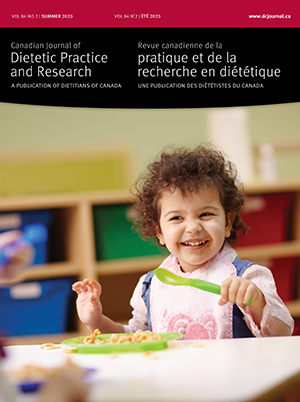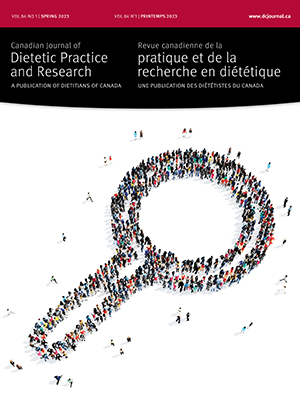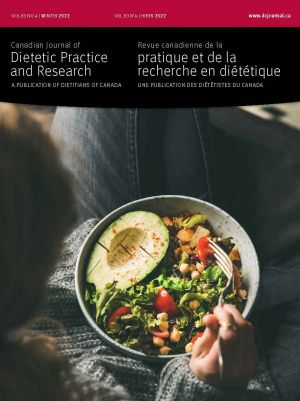Volume 69 • Number 2 • July 2008
Chair’s Message
Editor’s Message
Research
Purpose: Information needs and current information sources related to healthy eating, active living, and healthy body weight were examined in women attending breast cancer risk assessment clinics. Methods: Convenience sampling was used to recruit 257 women over 20 years old. The women completed a selfadministered survey (52.8% response rate) containing both closed- and open-ended questions. Most respondents were 49 or younger, were English-speaking, reported annual family incomes over $140,000, and resided in urban communities. Results: Participants reported a need for general information concerning healthy eating, active living, and healthy body weight. For example, they wanted information on reading food labels (51.0%), healthy recipes (51.0%), activities for increasing overall fitness (52.5%), and achieving healthy body weights (48.6%). They also wanted information concerning the relationships between cancer risk and specific foods and nutrients, such as antioxidants (65.0%), supplements (60.7%), phytochemicals (47.5%), and omega-3 fatty acids (45.5%). Participants most often turned to magazines, friends, and family members when they wanted information on healthy eating, active living, and healthy body weight. Conclusions: These findings present an opportunity for dietitians to enhance their leadership role in creating and disseminating evidence-based information to meet the expressed needs of women who may be at increased risk for breast cancer.
Purpose: To gain insight into the decision-making processes used by women when selecting dairy and dairy alternative foods, including examination of the role of bone health concerns. Methods: Semi-structured, point-of-purchase interviews were conducted with a convenience sample of 30 female grocery shoppers. Constant comparative data analysis was used to generate themes on shoppers’ decision-making processes. Results: Women considered multiple issues in their dairy and dairy alternative food choice strategies: taste was most often associated with the fat and sugar content of foods; health concerns were centred on achieving an acceptable body weight and preventing osteoporosis and cardiovascular disease, and women chose foods to satisfy other family members’ needs and preferences and to obtain “good food value.” Women prioritized their food choices by weighing the value of each issue, which led to a strategic process for “maximizing the value” of their food choices. The availability of a wide range of dairy and dairy alternative foods meant that in most instances, it was unnecessary for women to “trade off” one area of concern for another. Conclusions: Dietitians and nutrition educators can help women make dietary changes by helping them identify foods that they perceive as meeting a variety of needs.
Purpose: Dietitians must pass the Canadian Dietetic Registration Examination (CDRE) to practise. Writers’ experiences with the exam were examined, along with factors associated with anxiety and coping mechanisms, preparation strategies, and if and how anxiety, coping, and preparation strategies are perceived to be related to exam performance. Methods: An exploratory descriptive methodology with a researcher-designed questionnaire was used to collect data from a purposive sample in 1999 and 2000 (n=54), and from a convenience sample in 2005 and 2006 (n=11). Participants were CDRE writers from Nova Scotia, New Brunswick, and Ontario. Results: Meaningful preparation was correlated with a more positive exam experience (p=0.023). Writers experiencing lower preparation anxiety were more confident they had passed (p=0.016). Successful coping strategies resulted in decreased writing anxiety (p=0.029). The 2005 to 2006 cohorts prepared less (p=0.004) and experienced less preparation anxiety (p=0.02). Five themes emerged, which extend our understanding of the exam-writing experience. Conclusions: Several strategies may positively influence writing anxiety and improve the overall writing experience. Individuals and organizations and/or writers can consider these findings as they engage in the exam process, revise and/or develop support material, give presentations, or provide advice.
Purpose: Regular, non-therapeutic diets were examined in long-term care (LTC) residents to determine whether these residents consumed adequate nutrients according to current recommendations. Methods: Elderly (88 ± 8 years) residents (31 female, 17 male) in five Saskatoon LTC centres participated. All were receiving regular diets. Dietary intakes were collected for three days at breakfast, lunch, and dinner, by using simultaneous weighed and observation methods. Snacks provided and eaten were also recorded. Results: Observed intakes provided more complete data on nutrient intake than did weighed intakes. Inadequacy was most prevalent (in 70% or more of participants) for folate (according to prefortification intake levels), magnesium, zinc, vitamin E, and vitamin B6; inadequacy prevalence was below 50% for protein, vitamin C, and thiamine. Mean intakes of calcium, vitamin D, and dietary fibre were well below their respective Adequate Intake (AI) values. Energy consumed at meals and with snacks was 16% less than that offered at meals alone; other nutrients ingested ranged from 0% to 32% below energy offered. To model nutrient planning, target usual intake distributions were calculated where possible. Conclusions: These data suggest that nutrient-dense foods alone may not allow elderly LTC residents to meet intake requirements for many nutrients. Assessment of dietary adequacy in institutionalized elderly people allows for the development of realistic nutrition goals.
Perspectives in Practice
A nutritional screening and early intervention program was administered to older adults in a subacute care facility. The study group was recruited among patients aged 65 or older, who were admitted to the geriatric and rehabilitation units of two hospitals. Two simple, reliable, and valid tools were used to screen subjects for the risk or presence of malnutrition. Those determined to be at high nutritional risk (n=62) were included in the study. Dietitians then conducted a full nutritional assessment and implemented a nutritional care plan for these subjects. Weekly follow-up was completed to measure oral intake, weight, and biochemical indices. A Short-Form 36 Health Survey was administered upon admission and discharge. Results showed significant increases in energy (p=0.0001) and protein (p=0.01) intakes, and in serum albumin (p=0.001), prealbumin (p=0.003), transferrin (p=0.024), and hematocrit (p=0.026) levels. There was also a significant increase in seven of the eight dimensions of the healthrelated quality of life questionnaire (p<0.05). Outcomes improve when older adults are screened for the risk or presence of malnutrition and receive an early nutritional care program.
Report
Purpose: To compare dietary intakes of individuals with and without familial history of obesity (FHO) with recommendations from Canada’s Food Guide to Healthy Eating (CFGHE). Methods: This cross-sectional study recruited 197 women and 129 men with a body mass index of less than 30kg/m2 from the Quebec City metropolitan area. A dietitian obtained their dietary intakes, using a food frequency questionnaire. Results: Daily energy, macronutrient, and fibre intakes were not significantly different between individuals with and without FHO. No significant differences in the proportion of individuals who achieved the minimum CFGHE recommendations were observed between individuals with and without FHO. Conclusions: Findings of our study suggest that individuals with and without FHO have comparable dietary intakes when compared to Canadian dietary guidelines.
Purpose: To evaluate initiation and duration of breastfeeding of infants born to mothers who participated in the Early Childhood Initiative (ECI) program. Factors affecting the initiation and the early cessation of breastfeeding were also explored. Methods: Twenty-five pregnant women participating in the ECI program completed this prospective study. At 36 weeks’ gestation, a questionnaire was administered to assess socioeconomic status, intention to breastfeed and breastfeeding experience. When the infants were three and six months of age, feeding practices were assessed with a questionnaire. Results: The breastfeeding initiation rate was 62.5%. At one and three months postpartum, exclusive breastfeeding rates were 39% and 4%, respectively. At six months, none of the women was exclusively breastfeeding. Primiparity, prenatal classes, having been breastfed and intention to breastfeed at 36 weeks’ gestation were positively associated with breastfeeding initiation. Father’s education, intention to breastfeed at 36 weeks’ gestation, no water or formula given to the infant during hospitalization and higher maternal hemoglobin level at 36 weeks’ gestation were positively associated with the duration of breastfeeding. Conclusions: The rate of initiation and duration of breastfeeding for ECI participants were low. To achieve successful interventions, it is important to target modifiable factors known to influence the initiation and duration of breastfeeding within this population.
Purpose: The notion of transferable skills is part of the comprehensive education model for dietetic practice. Dietitians’ perspectives were collected to determine their understanding of the concept and which dietetic skills they considered transferable in long-term and acute care environments. Methods: The study included a purposive sample of 14 dietitians representing long-term and acute care internship training and employment. The dietitians completed a questionnaire and were interviewed. Results: All respondents demonstrated an understanding of the concept of transferability of skills. Results indicated that the majority believed dietetic entry-level competencies could be achieved in both long-term and acute care environments. While the majority believed competencies could be transferred from one environment to another, issues were raised about transfer from long-term care to acute care. These issues included limited client communication, fewer resources, and less opportunity for exposure to skill areas. Interpretation of the term “skill,” one-way transferability, and level of competence required for the particular working environment emerged as challenges to operationalization of the concept. Conclusions: Transferability of skills within dietetic practice requires further investigation if it is to be fully understood and used to its full potential.










